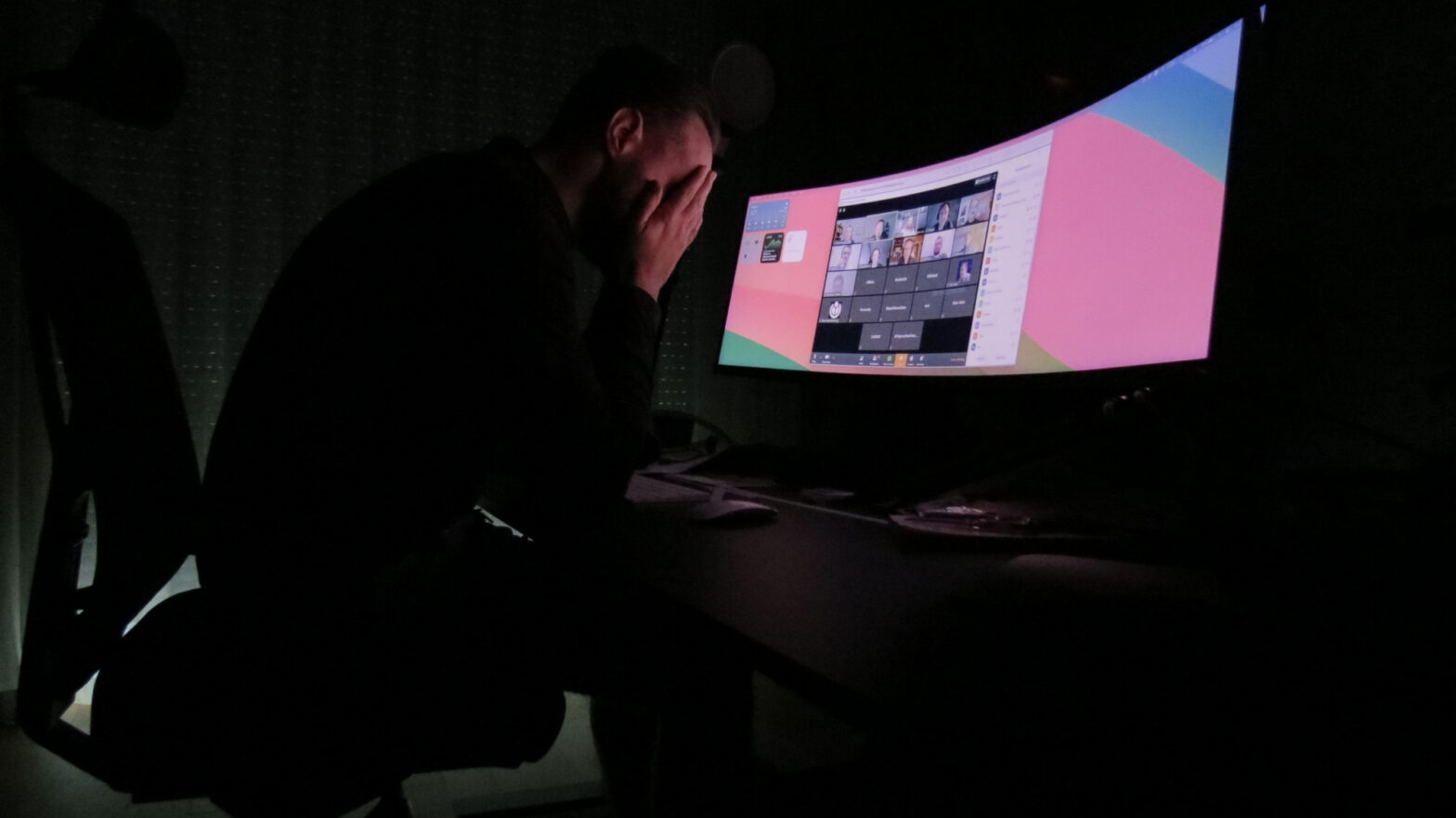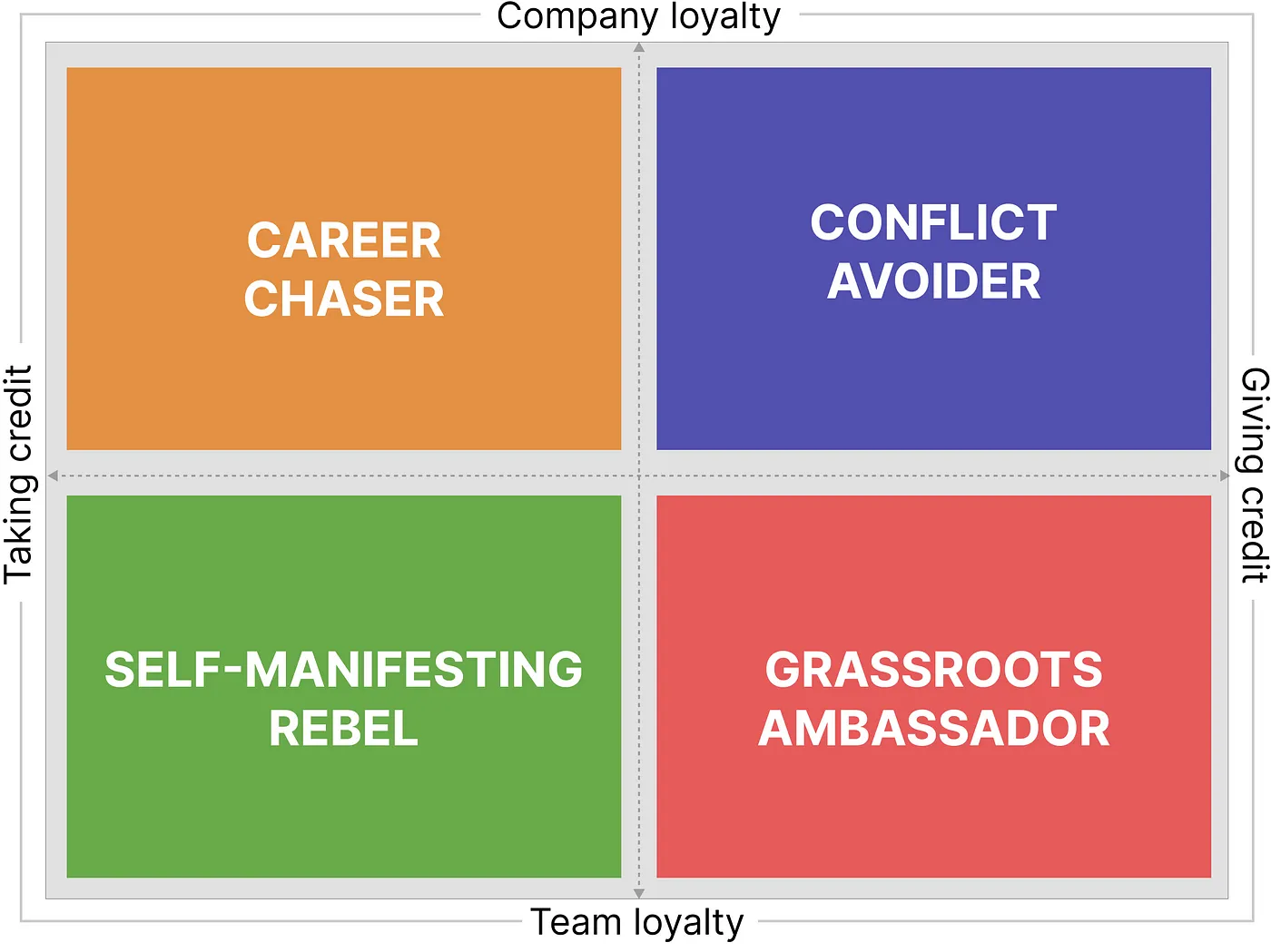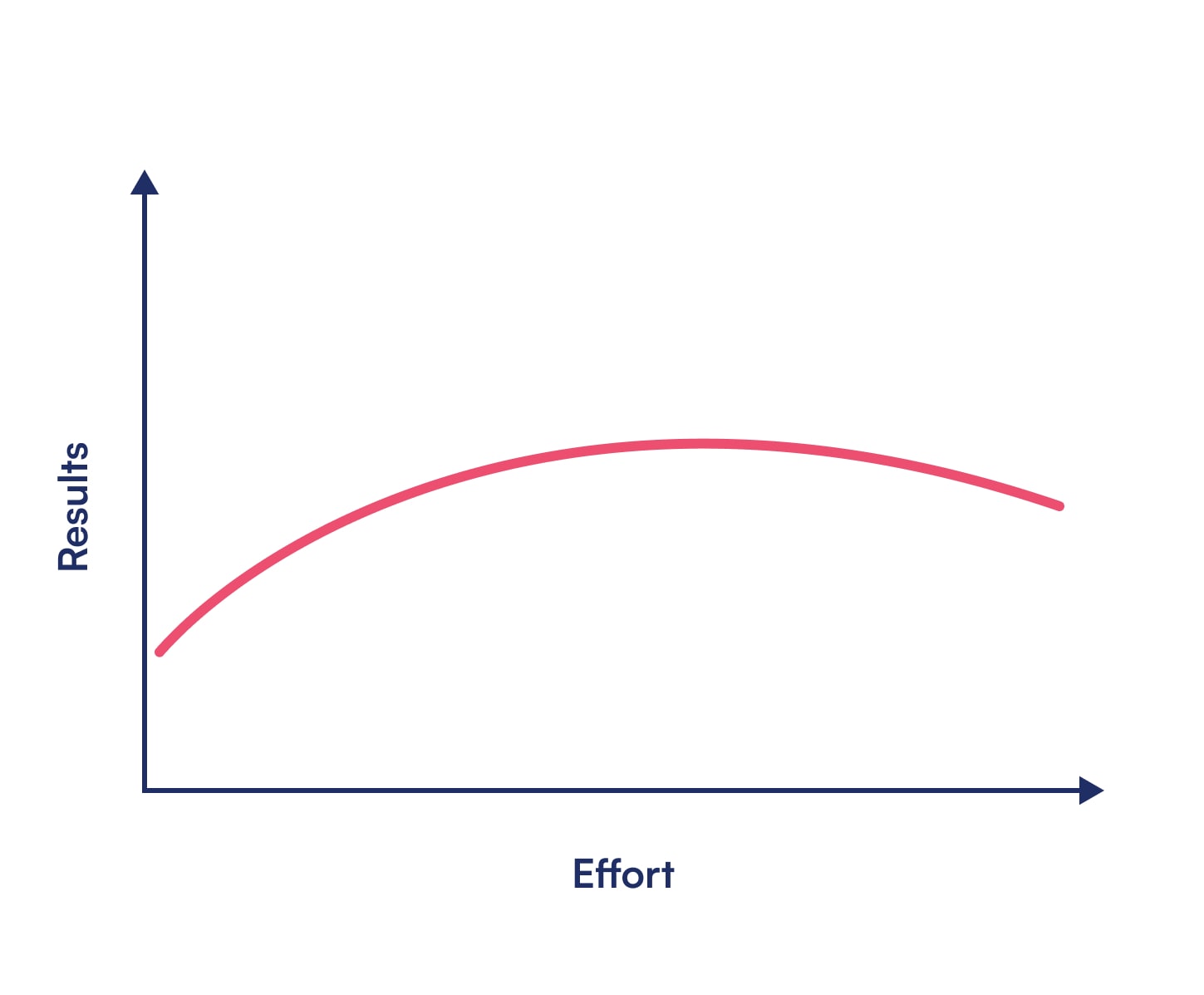Or why you should quit your dead-end job before it’s too late

There I was, sitting in the dark, behind the messy desk in my unfinished home office, head in my hands. The only light in the room was coming from the screen in front of me, I was in another late afternoon meeting, hiding behind my avatar.
🤫 Psst! My new online course UX Buddy helps designers create their UX portfolio, find, and get an awesome UX design job with a UX/design-mature company. It’s now live and enrolment is open for a couple more days. Check it out!
Just like so many times lately, I had turned my camera off, even though it was the department meeting with all my design peers and leaders. It was unusual for someone to turn off their camera during this call but I was burned out, had developed a social anxiety, and just couldn’t bring myself to show my face, let alone speak.
“Where did it all go so wrong?” I was thinking, paying no attention to what was being discussed in the meeting. I had no answers back then, only now, more than a year after getting laid off I finally processed everything that happened in those years. I realised that it started as a dream job but gradually turned into a nightmare. Here’s what happened and my recommendations based on what I learned so that you don’t make the same mistakes as I did.
I set my baseline too high
I joined this company as a senior product designer but I’d been a lead designer at the previous company. I went from commuting to an office in central London to a remote job at a company with a lot of potential so I was ok with that.
It was the right thing to do, but looking back now I realise that, combined with other factors described in this article, it set me up for failure right at the start. I guess the “demotion” must have lingered somewhere in my mind as I wanted to prove that I was not “just a senior designer” and wanted to get back into a lead role as soon as possible. But the company’s UX department was so immature at the beginning it didn’t have any design leaders, except the one manager that was in charge of the whole department.
Because of this desire and willingness to prove myself, I set a baseline of productivity for myself that was unsustainable. I could keep up with it for around three years, but then things started to fall apart, especially when there was still no acknowledgement and recognition of all the effort I put in and I started to burn out.
My recommendation: tune down your willingness to prove yourself
In my design career now spanning two decades, every designer I saw join a team where I had worked came in with a high willingness to prove themselves. I think it’s something designers especially default to because we’re constantly reminded that we need to prove our value. It happens so often that it has a detrimental effect on our confidence, so when we join a new company we want to do exceptionally well.
Here’s what you should do instead: Take it easy, don’t rush and tune down your willingness to prove yourself. Don’t take your job as a competition of who’s a better designer on the team but as a privilege to design things for people to use.
There need to be clear signs of growth in your performance to advance in your career. Starting high and maintaining that won’t get you noticed. It’s impossible to improve when you start at your maximum. The only way from the top is down. Save your energy instead and make sure you grow in your performance.
Anna Saraceno from Trello offers great advice on how to start a design job well. You should focus first on building relationships, then on producing great work and you should observe with a helpful eye and ask questions with an open mind. There’s no “hitting the ground running” when it comes to designers starting jobs. That’s a myth that toxic company cultures perpetuate. Don’t fall for it.
I wasn’t transparent about my career ambitions
I went from being a lead designer in a prominent British enterprise to a senior designer in a tech startup. This also means that I went from working on strategic initiatives and projects to mostly transactional and reactive work. I could still do strategy when time permitted, but there were just so many fires to put out that I was always running out of time.
The best way for me to get back to more strategic work with higher impact was to get promoted to a lead designer or an equivalent. That’s also why I set my baseline so high, I wanted to prove that I can do more.
But here’s what I did wrong: I always assumed that the manager would notice the effort that I put in and eventually recommend me for a promotion. That works when you have a capable manager who recognises good work and the efforts of their team members. My manager wasn’t like that. Looking back I now realise we were both at fault for things going wrong: me for not being transparent and expecting managers to notice my efforts, and them for not recognising all the good work I did.
Being quiet about your ambitions and expecting your manager to notice promotion-worthy efforts isn’t how things generally work when it comes to promotions. A promotion is something you plan with your manager and it doesn’t happen overnight. That’s why transparency about your ambitions is critical.
My recommendation: Take responsibility for your career progression
Designers need to be more proactive when it comes to their careers. My research for Why Designers Quit shows that there’s a glass ceiling in designers’ careers. Getting promoted is hard and it’s highly unlikely that the promotion will come to you on its own. Don’t just wait for your manager to notice all the good work that you do. Tell them about your ambitions and regularly remind them of the good work you do in your 1-on-1 calls.
Prepare a career growth plan with them, check in on it regularly, and ask them for feedback as you go. Are you moving along the plan accordingly or do you need to change something? This career plan needs to consist of your mid-term but also long-term ambitions. Do you want to get promoted? Add it to your career plan and discuss with your manager how you can get there.
If you need a template for your career growth plan, here’s a good one I found by Jen Matos on Miro. Here’s the blog post that explains how to use it.
I was too humble
Every tech company claims to hire humble people who work well with others. But is it possible to be too humble? And how come even in such companies it’s the vocal people who get ahead?
My work was stellar — I created and led complex strategic design initiatives, unlike most of my peers. I had great results to show for it too. Massive increases in important business metrics. None of the other designers had that, yet when it was time for acknowledgements and recognitions, I was always forgotten about.
It turns out that the working environment at the company was highly toxic. I didn’t realise this when I was there because they disguised it so well with toxic positivity. Everyone was extremely positive all the time, especially the leaders, so when you wanted to discuss the things that weren’t working you’d be seen as a party pooper. That’s why it was easy to get recognition for average work that aligned with that toxic positivity, but if you did awesome work but exposed serious problems, they’d shush you down and sweep the problem under the carpet. This is a typical symptom of a toxic working environment:
The more toxic your environment, the less you will get the recognition you deserve.
— Bas Wallet (Source)
In feminine countries, humbleness is a virtue. Claiming credit is not done Bas Wallet writes in Why does my UX manager not give me recognition for my work? I was raised by three women, no men were involved in my upbringing. This means that humility is built into me. Showing off for the things I do well feels wrong and I can’t do it even if my career depends on it. So again, I defaulted to waiting for someone to notice my efforts and my good work. Combined with the high baseline I had established for myself, not being transparent about my career ambitions, and my manager being unable or unwilling to notice my efforts, there was only one way this was heading — burnout.
My recommendation: be a good collaborator but don’t be too humble
When companies say that they want to hire humble people, what they mean is they want good collaborators but for some reason, they package it as humility.
Unless you work in a country or a company with a dominant feminine culture where humility is a true virtue (if you work in tech it’s unlikely you work in such a company), then you will need to find a good balance between being humble and promoting the good work you do. If you did something great, show it to your manager, that’s not bragging. If your manager doesn’t give you credit for a job well done, talk about your achievements to your manager’s manager or share it in public meetings or spaces like Slack.
My manager was a career chaser, based on Wallet’s definitions of managers and why they don’t give recognition. A career chaser takes credit for your work and is loyal only to the company which means they’ll throw you under the bus if needed. The other types are (Fig 1): Conflict avoiders who give credit but are still loyal only to the company, Self-manifesting rebels who take credit for the good work but without bad intentions, and then there’s the Grassroots ambassador who is closest to the perfect manager. They protect you and give you credit for the good work.

Dealing with a career chaser is hard. Confronting them doesn’t work because they’ll start to gaslight you. But I didn’t know who I was dealing with at the time and walked right into the trap.
I was gaslighted and let it get to me
Unfortunately, this has been happening to so many designers lately. “Prove your value” their leaders will say to them. “If you did your job better, you’d have the seat at the table” is another common thing designers hear. And that’s not even from other stakeholders, it’s from their managers. Instead of being supported and enabled to do their best work, they’re betrayed by their leaders.
After I burned out, I decided enough was enough. I confronted my manager and told them how I felt misguided by them and complained about how they never acknowledged my contributions. I expected a mature response but all I witnessed was responsibility shifting. I was to blame for everything. “You never told me that you had problems with productivity or motivation…” was something they said. “You were keeping track of your burnout score but still burned out…” was what they said when I confronted them about burnout and how they never noticed the obvious signs even though it was their responsibility, written explicitly in the handbook of the company.
As it turns out, it’s much harder to notice the signs of burnout in yourself than it is in others. But you have to know what you’re looking for, and a competent manager should be trained and able to do so.
External passive forms of burnout are easier to observe if you know what you’re looking for. Are your employees lowering their usual standards of performance, withdrawing effort, relaxing the rules, missing deadlines, or expressing more cynicism? These are side effects of burnout-related apathy. If allowed to fester, burnout can result in extreme avoidance behaviours, such as sidestepping interactions with coworkers, not speaking up when they have an idea or when something’s wrong, or letting problems slip by that they would usually address.
— Margaret M. Luciano and Joan F. Brett in Do You Know Burnout When You See It? (Harvard Business Review)
So we argued for a couple of weeks during our 1-on-1s until I decided to stop. I realised that I was being gaslighted by an incompetent manager with a lot of insecurities. Whenever I tried to confront them about something, they always found a way to blame me in the end. No matter how hard I worked it was never enough. Sara Wacther-Boettcher came to the same conclusion in Hey designers, they’re gaslighting you: you cannot overwork your way into being valued. You cannot explain or fight your way into being valued. You can’t prove your value to someone who isn’t interested in seeing it. This is mostly true for designers’ relationships with other stakeholders, but sadly, it’s also often true for their relationships with their managers.
My recommendation: Learn to recognise the signs of gaslighting and don’t let it get to you
When you try to confront someone about something you think they’re doing wrong but in the end, they always find a way to blame you, possibly to the point where you think you’re losing your mind, that’s when you’re being gaslighted. The first part is recognising it, so here are a few things that gaslighters do that I think are especially relevant to designers (Source):
- Blame shifting in relationships—saying that if you acted differently, they wouldn’t treat you like this, so it’s really your fault
- Twisting a story to minimize their abusive behaviour
- Minimizing their hurtful behaviours or words by saying something like, “It was just a joke” or “You’re way too sensitive”
- Changing the subject or refusing to listen when confronted about a lie or other gaslighting behaviour
- Saying things like “If you aren’t showing your value to the leadership, you’re failing.”
The second part is not letting it get to you. In professional environments, the person who’s doing the gaslighting rarely does it to harm others. It’s often a way to protect themselves from their insecurities. So it’s not about you, it’s about them. Let it go and move on to the third part.
The third part is to do something about it: speak to their manager if you truly think it can help. It rarely does so you might need alternatives. Switching to a different team is the best one if you want to stay with the company. When that’s not an option, switching jobs is the only thing that remains. Being gaslighted is detrimental to your mental health, it may erode your confidence to the point of ending your career.
Conclusion: My dream job had turned into a dead-end job but I refused to see it
I managed to switch to a different team and even started to recover from burnout (after more than six months). I had considered leaving the company at some point but I always thought that things weren’t that bad (they were!).
My wife and I were expecting twins at the time when I burned out. It was a really hard period in my life but at least it made the decision to remain an easy one. If I stayed, I’d get four months of paid parental leave. If I left and joined a new company I’d have to work through the first months after our babies were born.
That never happened. Two months before our twins were due I got laid off. You can read more about that story and other designer layoff stories in my post Designer Layoff Stories. It’s a sad read but it can help you prepare for the inevitable.
My last recommendation: Don’t persist in a dead-end job
Why do most people persist with their job even though it makes them unhappy? According to Seth Godin, “Quitting takes a lot more guts than continuing to be carried along like debris on an ocean wave.” In his book The Dip, he argues that people get caught up in the “sunk cost fallacy.” Having invested so much time into something, we hate to leave it.
Quitting our job would mean that we wasted our time because we invested so much of it in it. This thinking isn’t rational, but it is human. He explains it with a Results/Effort chart (Fig 2) — you put more effort into the dead-end job but things continually and gradually get worse. Still, this is easier than finding a new, better job.

There’s no point in persisting in a dead-end job. No matter how much effort you put in, things won’t get better. They always get worse.
Don’t persist in a dead-end job. First, you have to recognise that a job is a dead-end. That’s the hardest part and it may take a while. Here are a couple of good guidelines for designers:
- If you’ve been a designer at a company for two years, been doing great work but received little recognition and your manager isn’t talking to you about your potential promotion, it’s a dead-end job.
- If the design team is small and no designers are being promoted, it’s a dead-end job.
- If all you are asked to do is transactional and reactive work, with little research, discovery, and UX strategy, it’s a dead-end job.
- If you’re stuck with an incompetent manager who continually gaslights you, it’s a dead-end job.
Don’t despair, but see this time as a transitional period of your career as Bas Wallet puts it perfectly again. When it comes to your career you always need to think longer term. When you’re stuck at a dead-end job, longer-term planning means you need to do your best possible job in your current situation, build up your portfolio and leave for greener pastures.
My situation was very particular and I couldn’t leave. I’d jeopardise the precious first few months with our babies. Ironically, getting laid off had the same effect — it pushed my life into chaos as I scrambled to put the pieces back in place. I never got to spend the first few months with them carefree. It was too late for me.
My job started well and became a dream design job for the first three years but still turned into a nightmare. Chances are you’re sitting at a much worse job, one that is a dead-end job from the start like so many designers do. Gather up the courage, summon all your strength, invest your effort in your portfolio and leave. It’s harder short term, but longer term it’s the only thing that makes sense. Just don’t be the debris on an ocean wave, tumbling around and never getting anywhere.
🤫 Another gentle reminder! My new online course UX Buddy helps designers create their UX portfolio, find, and get an awesome UX design job with a UX/design-mature company. It’s now live and enrolment is open for a couple more days. Check it out!

Thank you for sharing your personal experience and insights on navigating challenges in the design industry. Your honesty and resilience are truly admirable and inspiring.
Much obliged to you for sharing your fearless excursion, Matej. Your straightforwardness in exploring difficulties motivates many hopeful creators such as myself. I wish you continued professional fulfillment and success.
Outstanding story there. What occurred after?Taake
care!